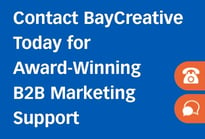Social media isn’t just for duck-faced selfies. In fact, social media can be a valuable tool for B2B companies.
Fifty-five percent of B2B buyers search for product and vendor information on social media. And if you’re not there, they’re going to find your competition instead of you.
You’re probably not going to be able to pull a prospect all the way down your sales funnel with just social media. But it’s a valuable tool for distributing your content and promoting your business and product/solutions.
Like any other B2B marketing effort, though, you have to do it right, or you’re just wasting your time and money. So here are a baker’s dozen tips to help you maximize your B2B social media marketing efforts.
Tips for B2B Social Media
- Post where your audience is. The first step is to choose the right social platform, the one(s) your prospects use. It’s best to start with one platform and focus your efforts on that one, and then add more as you build up your content base.
- Study your audience demographics and develop an audience persona to help you write content specific to its pain points.
- Continuously be adding content to your website so you have items to promote on social media. Make sure that each piece of new content offers something of value for the audience, and then play up that value element in your social media posts.
- Remember, it’s not all about you. Sure, you want to promote your new white paper, but when you promote it, talk about why your audience would want to know about it. In all cases, think about how you can make the post about those personas you created.
- Bring something new and different to the conversation. Get creative not only with your social media posts, but also with the content that feeds those posts. You want to stand apart from your competition, and the way to do that is by being different.
- Connect with or follow your prospects. Listen to what they post. Monitor what content they consume, what they share, and how they engage with brands and people. You might even be able to glean some pain points they’re experiencing.
- Which leads us to this next point: Don’t simply follow or connect with them. Engage with them. When they ask a question of their community, try to answer. When they express frustration with a pain point, try to offer a solution.
- Engage with your followers, as well. Respond when someone comments on your posts. Ask thought-provoking, relevant questions as a way to get them to interact with you. Follow trending hashtags in your industry; identify groups of industry experts and thought leaders; participate in conversations. That’s a great way to grow your social media community.
- Join the social media conversation during events such as trade shows—even if you’re not there. If you use the correct hashtags, you’ll be seen even by people who aren’t connected or following you, and if they like what you have to say, maybe they’ll start following you.
- Incorporate video to mix things up.
- Try paid social media. That can allow you to talk to targeted prospects who aren’t in your connected community. And with PPC advertising, this approach can be surprisingly affordable.
- Be sure to align your social media posts with sales and other internal teams, so that you’re all pushing in the same direction.
- Track, measure, and optimize your efforts.
Become a Part of the Conversation
Social media is a part of everyday life for most people. And with a little savviness and plenty of effort, you can use that to your advantage when marketing your B2B product/solution.
If you need help creating content or managing your social media personality, let us know. BayCreative, a full-service marketing firm in San Francisco, has a team of writers who specialize in writing compelling B2B content that can drive any social media campaign. Or, if maintaining this level of social media vigilance seems too taxing on your internal resources, we can handle your social media efforts.
Just let us know how we can help.
All the best,
- Team BayCreative -

